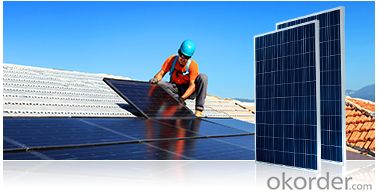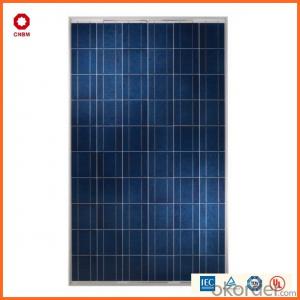200W Monocrystalline Silicon Solar Module With CE/IEC/TUV/ISO Approval Standard Solar
- Loading Port:
- Guangzhou
- Payment Terms:
- TT OR LC
- Min Order Qty:
- 100 watt
- Supply Capability:
- 1000000 watt/month
OKorder Service Pledge
OKorder Financial Service
You Might Also Like
Item specifice
Solar 200W Monocrystalline Silicon Solar Module With CE/IEC/TUV/ISO Approval Standard Solar
CNBM International Corporation is a professional solar panel manufacturer in China for CNBM brand . Silicon panel ( silicon module), as our main product, has high quality and good service. Our products are very popular in Europe, Australia, England, Middle East, Mexico, Argentina, Chili, Singapore and Africa.
Furthermore, our products have gained international authorized certificates like TUV, UL and CE.
China National Building Material (Group) Corporation (CNBM), established in 1984, is one of the largest State-owned group corporations of building & mechanical materials which specializes in the design, manufacturing and distribution of building materials in the world.
As the whole world turns “green”, CNBM enters into the Photovoltaic Industry in 2005.After 6 years' fast growth, now our annual capacity is 500MW solar panel and 500MW solar cell.

We now provide
• Monocrystalline Solar Panel
• Polycrystalline Solar Panel( multicrystalline silicon Solar Panel)
Features of our products:
Long lifespan: 25Years lifetime guarantee, 12years workshop warranty. 90% output in first 10years. 85% output in next 15years.If module fail during warranty period, please contact local dealer, and provide the warranty card to replace the products.
Solar panels are withstand extreme working condition (from -40°C to 120°C)
Grade A solar panels rated by TUV.
High transformation efficiency solar panels
New UV reflector protected Layer
Maintenance free solar panels
No exposed metal parts
Custom-made available
100% EL TEST before and after laminator for each solar panels
TUV,MCS,CEC,IEC61215,IEC61730,CE,UL approved solar panels
CHUBB insurance company to guarantee the quality of solar panels
Bankable solar panels in German,Italy,UK,Denmark country
As a professional Solar Panel manufacturer and Supplier in China, we have our customers come around the whole world and our specialization has got a worldwide recognition. Meanwhile, with our superior quality, competitive price, prompt and excellent service, As main role in trade section of CNBM Group, CNBM International Corporation supplies products including Monocrystalline Solar Panel, Polycrystalline Solar Panel ( multicrystalline silicon Solar Panel) have received and enjoyed famous reputation in many countries and regions in the world.
- Q:What i would like to know is if you were using commercially available solar panels, clustered as close together as possible and spread out on one acre, how much electrical energy is produced? if u can 'translate' this into terms of ( hour of average daylight = powering a ____ for X units of time)
- Above the atmosphere, total solar flux is about 365 Watts per square meter. After passing through the atmosphere, the rule of thumb is about 000 Watts per square meter if the Sun is directly overhead. Solar panels are far from 00% efficient, though ... most silicon-based cells run about 20% efficiency. Which leaves you with roughly 200 Watts per square meter. One acre is 4046 square meters, which means that if you had an entire acre of silicon solar panels, they could generate a theoretical 800 kilowatts on a sunny day at noon. With the Sun 30° above the horizon, you could expect a 30% drop in power, declining to zero at sunrise and sunset. And that's assuming zero cloud cover, which is also an unreachable ideal. To give you an idea of scale, an average American home uses or 2 kilowatts. A large coal or nuclear power plant generates about a million kilowatts.
- Q:And how do you choose the best one for the best price?I saw a 400 watt monocrystalline solar panel
- In regards to my research about these two types of Solar Panels, I suggest that the Monocrystalline Solar Panel would be great! It is affordable and also more convenient to install. Using a 400W Panel means fewer panels and less installation time, in addition to fewer connections and transmission losses which results in big savings and a faster return on your investment.The Topsun Solar Panels boasts efficiency of up to 6.77% and use cutting edge technology for the best heat dissipation in the industry.
- Q:how to make electricty using solar panels or wind generator
- there's a e book called hand-crafted potential that covers making photo voltaic cells and panels. some extra progressive libraries have it. in the different case its a visit to the OKorder save (which style of kills the finished loose deal). in case you meant warmth air panels or warm water panels then there are extremely some books interior the library that cover that subject. mom Earth information mag also has had many articles on both photo voltaic/electric powered and photo voltaic warmth panels. in the journey that your library consists of adult males mag and keeps decrease back subject matters of their stacks.
- Q:What is the difference between Photovoltaic Panels and Solar Panels?
- Both of them are different types of solar panel. EDIT: Misspelling on Jeff's answer below! I think he means 'silicon,' not 'silicone!' Solar cells are typically grown on a glass substrate or put onto glass. Silicon is currently the most common material, followed by CdTe or cadmium telluride. Other materials like CIGS (Copper Indium Gallium (di)Selenide) are breaking into the market. Some people have great hopes for organic or 'dye' solar cells.
- Q:I had someone quote me for solar panels on my house but I can't afford it. They were talking about how I have enough room and the perfect location to put many of them and actually get paid for it. I have about a half acre that is tiered and points in the correct direction for them to get pretty much the full day sun. Additionally, I live in so cal where it is sunny most of the year. Does anyone know if solar companies will lease or install them to get the payback? I would be happy to allow them to use the land just to cover my electrical expense and they could have any payback.
- There okorder /... The article below gives some other creative ways to finance a PV system.
- Q:This is the cenario. Your yearly energy use comes by mail and it states that the total amount of energy used your household is 7000kWh.Then you make the decision of switching to get solar panels. The question is what area should your solar panel be given that the average annual length of daylight is 2.0.
- It is not that simple. There are 3 main types of solar cells. Monocrystalline silicon is the most efficient and produces the smallest solar cells, and therefore the smallest panels. Poly-crystalline (or multi-crystalline) silicon produces the next most efficient type of cells and are a popular choice. Amorphous (or thin-film) silicon uses the least amount of silicon and also produces the least efficient solar cells. This means thin film system take up more area than the other two; an important factor to consider in relation to possible future upgrades; i.e. if you'll have enough space left to do so. The North (in the Southern hemisphere) or South (in the Northern hemisphere) facing roof collects the most energy. So this biases the roof area required. Your energy usage can be changed. Hot water (a major energy user) could be better using direct solar heating with peak demand boosting, either from mains or solar. There are other possibilities, either to reduce demand or to provide energy from other sources. Not all sunshine hours are equal. Hours around midday are far more productive than hours later in the day. This must be factored in.
- Q:How do solar panels impact the electric bill?
- Solar panels can significantly reduce or even eliminate the electric bill. By generating electricity from sunlight, solar panels can offset the amount of power needed from the grid. This means that homeowners or businesses with solar panels can consume less electricity from the utility company, resulting in lower energy bills. In some cases, excess solar energy can be exported back to the grid, earning credits that further reduce the electric bill.
- Q:Hey was looking at a 5 watt 2 volt solar panel and was wondering if it'd be enough to power a regular light bulb. Also need to power a 5volt 6.5 amp pump for at most a minute at a time. So basically if I had this panel would I be able to plug a lamp into it and have it light for 5+ hours at a time with the possibility of running the pump? If not what size panel would I need?
- The specifications you give say the solar panel produces 5 watts at 2 volts (DC) so that isn't enough voltage to power an ordinary (20-volt) light bulb. You could get 0 of these panels and connect them in series so they put out a total of 20 volts and the total power available would be 50 watts. The panels would light the bulb that way, provided the bulb isn't over 50 watts and you can afford the panels. A panel does provide enough power for a 2-volt car light bulb less than 5 watts. However, the maximum current you can get from these panels is .25 amperes (5 watts divided by 2 volts = .25 A.) This isn't enough power to run your pump which takes 6.5 amperes - at 20 volts, that would be 780 watts. Another thing to check is the pump motor; many electric motors are designed to run on AC only and will be damaged if you try to run DC through them. Remember solar panels produce DC so the raw output from a panel will not work on an AC motor.
- Q:I have a solar panel I bought for a diy project and it has a small plug on the end of it, but I need to remove this plug to expose the positive and return wires so I can solder a bunch of stuff together. How do I cut off the plug without shorting out the solar panel when I make the cut? Can I just leave it in the dark a while before cutting? I don't think I can remove the wires from the solar panel end before cutting.
- Just cover the panel and cut the wire the voltage will be so low it would be like shorting out a battery
- Q:What is the working principle of solar panels?
- the material is easy to industrial production and material performance and stability.
1. Manufacturer Overview |
|
|---|---|
| Location | |
| Year Established | |
| Annual Output Value | |
| Main Markets | |
| Company Certifications | |
2. Manufacturer Certificates |
|
|---|---|
| a) Certification Name | |
| Range | |
| Reference | |
| Validity Period | |
3. Manufacturer Capability |
|
|---|---|
| a)Trade Capacity | |
| Nearest Port | |
| Export Percentage | |
| No.of Employees in Trade Department | |
| Language Spoken: | |
| b)Factory Information | |
| Factory Size: | |
| No. of Production Lines | |
| Contract Manufacturing | |
| Product Price Range | |
Send your message to us
200W Monocrystalline Silicon Solar Module With CE/IEC/TUV/ISO Approval Standard Solar
- Loading Port:
- Guangzhou
- Payment Terms:
- TT OR LC
- Min Order Qty:
- 100 watt
- Supply Capability:
- 1000000 watt/month
OKorder Service Pledge
OKorder Financial Service
Similar products
New products
Hot products
Related keywords




























